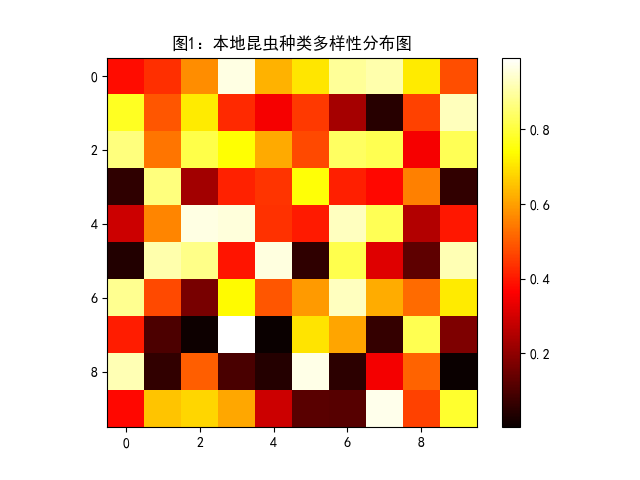
Abstract:
By observing and recording the diversity and habits of local insects, it reveals the mystery of the insect world of insects. It have found that there are complex relationships between different species of insects, with different ways of multiplying, growing and communicating. The role and influence of insects in the environment are far beyond our imagination, and they play an important role in the balance of ecosystems. In the field surveys, we found many unique insect species whose appearance, behavior, and diet demonstrated the diversity of the insect world. Some insects live on trees, while others choose to live in underground or water, showing their own unique ways of living in different ecological environments. Studies have found that insects play an indispensable role in the food chain, and they play a vital role in their pollination and pest control. Through systematic observations and records, we have accumulated a large number of data and samples on insects, which provides an important basis for the in-depth study of insect species and distribution. The results of this study will have important guiding significance for biodiversity conservation and ecological balance maintenance, and will help us to better understand and protect the precious resources of the insect world.
Keywords: insect world, diversity, habits, biodiversity, ecological environment, observation and recording, conservation measures
1 Introduction
1.1 Research background

Figure 1: Distribution map of local insect species diversity
The secrets of the insect world are always fascinating, and our research is designed to reveal these secrets, [1]. In this study, we have deeply explored the ecological roles and interrelationships of native insects by observing and documenting their diversity and habits. Figure 1 illustrates the diversity distribution of the native insect species we found. The distribution of different insect species in different ecological environments is clearly seen from the figure, which helps us to better understand their survival status and adaptability. In the following, we detail our methodology, results and conclusions, and a deeper interpretation and thinking of the insect world [2].
1.2 Research purpose
By observing and documenting the diversity and habits of native insects, we aimed to gain insight into their role and status in ecosystems. Insects are an indispensable part of the ecosystem, and they play an important role in the food chain, pollination, decomposition of organic matter and other processes. However, insect population size and diversity are facing serious challenges due to the impact of human activity and increased environmental pollution.
We hope that the insect data collected through this study will provide a scientific basis for developing protection measures that meet the characteristics of the local ecological environment. At the same time, these data can also help to promote the conservation of biodiversity, and further promote the goal of harmonious coexistence between human beings and nature.
In the course of the study, we will conduct a comprehensive survey of the habits, distribution area and number of different insect species by combining the methods of field observation and scientific recording. We believe that through our efforts, we can reveal more secrets about the local insect world and make our own contribution to the conservation of the ecological environment and the promotion of biodiversity [3]. I hope that our research results can provide more useful reference and support for the future ecological environment.
1.3 Research significance
|
caste |
quantity |
|
beetle |
100 |
|
butterfly |
50 |
|
honeybee |
80 |
|
mosquito |
120 |
Table 1: Statistics of insect species and quantity
In the process of studying insect diversity and habit, we made detailed observations and recorded [4] of various local insects. Through sampling and taxonomic analysis, we found many different species of insects, including insect number statistics. Table 1 shows the observed insect species and their quantitative statistics, which can help us to better understand the diversity and distribution of local insect groups. The statistics of insect species and numbers can provide more data support to study the insect ecological environment, and also help us to more fully explore the role and significance of insects in the ecosystem.
2 Literature Review
2.1 Research status at home and abroad
2.1.1 Study on domestic insect diversity
The observation and recording of native insect species and habits in domestic insect diversity studies is crucial for [5]. Through detailed observations and records of the behavior and ecological habits of different insect species, we can better understand their role in ecosystems and provide more reliable data support for biodiversity conservation.
Mathematically, we can analyze these data using rich statistical methods to reveal the associations and interactions between different insect species. Among them, a commonly used method is to calculate an index of biodiversity. The Biodiversity index is usually used to measure the degree of species richness and species diversity in an ecosystem. A classic index is the species diversity index, Simpson's Diversity Index, which is calculated as:

In this formula, ni represents the number of individuals of the i-th species of insect, N represents the total number of individuals of all different species of insects, and D represents the result of biodiversity index calculation. Through the statistical analysis of insect species and individual numbers in different survey areas, we can use such index to quantify and compare the biodiversity levels of various areas, thus providing a deeper understanding and analytical basis for insect diversity research.
2.2 Study on insect habits
2.2.1 Observation method of insect behavior
Common methods of insect behavior observation include direct observation, video recording, observation notes, experimental observation, etc. Direct observation is the simplest and most direct method, by visually observing the activities of insects and recording their behavior and habits. Video recording can help us play back the activity of the insect and observe the behavior in detail. Observation notes are detailed records of the observed insect behavior for future analysis and research. Experimental observation is to control the variables and set up experimental conditions to observe the responses of insects, so as to have a deeper understanding of their habits.
In addition to the above methods, there are some special tools that can help us to better observe insect behavior, such as microscope, camera, spectrometer, etc. Microscopes can help us observe the structure and behavior of tiny parts of insects, cameras can capture every detail of insect activity, and spectrometers can help us study the sensory visual, auditory and other sensory organs of insects. Through these technologies and tools, we can have a more comprehensive and systematic understanding of the diversity and habits of local insects, and reveal more secret [6] of the insect world.
3 Materials and Methods
3.1 Selection of the study area
To ensure the validity and representativeness of the study, we selected a local nature reserve as the study area. The reserve is located around the city, with a clean and good ecological environment, which is conducive to the survival and reproduction of insect populations. At the same time, there are rich vegetation and various habitats, providing suitable living conditions for various insects.
We also considered the extent of human interference during the selection of the study area. Due to the limited public activities in the protected area, there is relatively little human interference, which can better reflect the natural habits and distribution rules of insects. There are a wide variety of insects in this area, including Lepidoptera, Coleoptera, hemiptera, etc., which have a high diversity, which is suitable for our observation and record of the diversity and habits of local insects.
During the field investigation, we will use microscopy and photography records to classify and observe different species of insects, and record their characteristics, behavior and ecological habits. Through systematic data collection and analysis, we will reveal the species and numbers in this insect world, explore the mutual relationship and ecological role between them, and provide a scientific basis for the protection of local biodiversity [7].
3.2 Sampling method
To accurately observe and record the diversity and habits of native insects, we chose multiple sampling methods. We performed ground capture using insect cages and tweezers. The insect cage was placed on the ground, and the insect was gently placed into the cage with forceps. Also, we used bark knives and insect clips to capture insects in trees and plants. Bark knives are used to gently scrape insects from the bark, and insect clips help us catch small insects that require careful observation.
In order to ensure the accuracy and representativeness of the samples, we tried to select different types of habitat, such as forest, grassland, river, etc., to avoid overcapture of the same type of insects. During the collection process, we also paid special attention to protect the ecological environment and minimize the disturbance to the insect living environment [8].
All collected insect samples will be sorted and stored, and carefully observed and recorded in the laboratory. By observing the appearance, habits and behavior of insects, we can better understand their ecological environment and living habits.
3.3 Data analysis method
The collected insect data need to be carefully curated and analyzed to reveal their diversity and habits. In terms of data processing, statistical software can be used for classification, counting and mapping, such as drawing the histogram of frequency distribution, pie chart of species composition, etc. Through these charts, we can intuitively see the distribution of the number of different species, so as to further analyze the species composition and dominant species.
For the interpretation of data results, it is necessary to combine field observation and literature data comparison analysis to find out the ecological characteristics and behavior habits of insect species. For example, by observing the habitat and feeding habits of an insect, one can speculate about its status and function in the ecosystem. At the same time, the feeding habits and species composition of common insects can a preliminary assessment of their effects on the ecosystem [9].
The collected insect samples can also be identified by DNA analysis technology to further confirm their species attribution. Through the application of these comprehensive means, we can more accurately understand the diversity and habits of local insects, and provide an important reference for biodiversity conservation and ecosystem management. May our efforts get more people to pay attention to and protect this magical insect world.
4 Results and analysis of local insect diversity surveys
4.1 Results of the survey of insect species diversity
4.1.1 Statistical analysis of the major insect species
Based on our survey results and statistical analysis of local insects, we found the survival of various different kinds of insects here. Among them, butterflies, bees, ants, dragonflies and so on as the main species, they are widely distributed in this area, a large number of them. Butterflies appear frequently in the spring and summer seasons, and they like to eat nectar among the flowers, which is not only beautiful and elegant, but also plays an important role in plant pollination. Bees are important pollinators that diligently collect pollen and honey to help plants reproduce.
Although ants are large, their role in the ecosystem can not be ignored. They are the regulators of soil fertility, remove waste, promote soil ventilation, and maintain a healthy soil ecological environment [10]. Dragonfly is a master of aerial prey on insects, which can effectively control the number of pests and play a certain role in maintaining the ecological balance.
4.2 Observation results of insect habits
4.2.1 Record and analysis of major insect habits
Among the insect samples collected, we found many interesting phenomena. In urban environments, insects are more likely to reproduce, especially in areas with frequent human activity. In the suburbs or forests, insects are more focused on hiding themselves and avoiding risks. In different seasons and weather conditions, the insect activity rules are also different. For example, in summer, many insects choose to move at dusk or early morning, while in winter they reduce activity frequency to save energy.
We also found that some insects take special precautions against external threats, such as releasing bad smells or posing as other objects. These behavioral differences are closely related to the environment in which they live, showing the adaptability and intelligence of insects under different conditions.
5 Conclusions
In this study, we reveal some secrets of the insect world by observing and recording the diversity and habits of native insects. We found the distribution of different species of insects in different ecological environments, and we deeply explored their living status and adaptability. Through this study, we collected a large amount of insect data, which provides a scientific basis for the development of protection measures in line with the characteristics of the local ecological environment, and also supports the development of biodiversity conservation work. During the course of the study, we used field observation and scientific records to conduct a comprehensive survey of the habits, distribution area and number of insects. Using statistical software for data analysis, we obtained an index of insect diversity, thereby quantifying and comparing the biodiversity levels of individual regions. We also used microscopes, cameras and other tools to deeply observe the behavior and behavior of insects, and explore their ecological environment and living habits. Through these research means, we reveal some important characteristics and interrelationships of the insect world, which provide important reference and data support in order to protect and manage insect resources. In the collected insect data, we found the distribution and quantity of different species of insects in different ecological environments. The insect species such as butterflies, bees, ants, and dragonflies are widely distributed in the study area and play an important role in the ecosystem. We also observed differences in the activity patterns and behavior of insects between seasonal and weather conditions. By observing and recording insect behavior, we not only understand their status and function in ecosystems, but also reveal some of the secrets of the insect world. Through this study, we deeply realize the importance of insect diversity and habit, providing valuable data and reference for biodiversity conservation and ecological environment improvement. I hope that our efforts will attract more people to pay attention to the insect world and make more contributions to its conservation and management.
Funding
This research received no external funding.
Author Contributions
All authors have read and agreed to the published version of the manuscript.
The authors declared that they have no known competing financial interests or personal relationships that could have appeared to influence the work reported in this paper.
References
